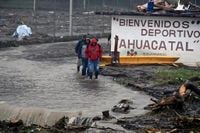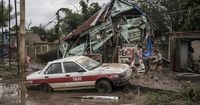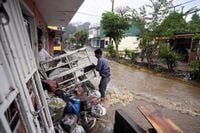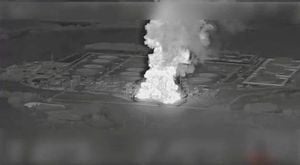In the early hours of October 10, 2025, the quiet streets of Poza Rica, a working-class oil town in Veracruz, Mexico, were shattered by an unstoppable wall of water. The Cazones River, swollen by relentless rain, burst its banks, sending more than 12 feet (4 meters) of muddy floodwater roaring through neighborhoods. Residents heard the chaos before they saw it—the sound of vehicles colliding as they were swept away, the crash of debris, and the desperate shouts of neighbors scrambling for safety.
This was no isolated incident. According to AFP and Mexico’s National Coordination of Civil Protection, at least 41 people have died across central and southeastern Mexico in recent days, as landslides and floods devastated communities. The disaster unfolded after a relentless barrage of rain that, between October 6 and 9, dumped over 21 inches (nearly 540 millimeters) of water on Veracruz state alone. The effects were catastrophic, with rivers overflowing, entire villages inundated, and roads and bridges collapsing under the force of nature.
In Poza Rica, the floodwaters arrived with little warning. Some residents sensed danger a couple of hours before dawn and managed to grab a few belongings before fleeing. Others, like 27-year-old Shadack Azuara, were caught off guard. Azuara went searching for his uncle at 3 a.m., only to find no answer at the door. He assumed his uncle had evacuated with others. But when he returned later, he found his uncle, a retired oil worker, lifeless and floating facedown in the murky water that had engulfed his home. "We thought he had gone, that he had evacuated with all of those who left," Azuara recounted, as reported by AP News.
The scale of destruction is staggering. In Veracruz, the army and navy have been deployed to assist with rescues in 42 communities left isolated by landslides and swollen streams. Across the Gulf Coast state’s 55 municipalities, more than 16,000 homes were damaged, leaving families to pick through the wreckage of their lives. The military response has been massive, with over 10,000 troops, boats, planes, and helicopters mobilized to open roads, deliver aid, and evacuate stranded residents. President Claudia Sheinbaum wrote on X, "We are deploying members and teams from the Mexican government to open roads and assist communities."
Elsewhere, the devastation is just as acute. In the central state of Hidalgo, at least 22 people have died, and 1,000 homes have been damaged. Some 90 communities remain inaccessible to rescuers, cut off by landslides and collapsed roads, as reported by the federal security secretariat. In Puebla, at least nine people have lost their lives, and around 80,000 residents have been affected by the extreme weather, according to state officials. Over 16,000 homes have been damaged or destroyed in the region. In Querétaro, a landslide earlier in the week claimed the life of a child, underscoring the danger posed by unstable terrain.
Across the country, the impact of the flooding has been felt far and wide. More than 320,000 people have suffered power outages, with 150 communities in Hidalgo alone left in the dark. Shelters have been opened for the thousands displaced, and relief organizations warn that supplies of food, water, and medicine are running low in many isolated areas. The main disaster zone has been the Sierra Madre Oriental, a mountain range paralleling the Gulf of Mexico coast, where small communities have been especially hard hit. Roads leading into the mountains have been closed off due to landslides and collapses, making rescue operations even more challenging, as observed by AFP correspondents in Tulancingo, Hidalgo.
The cause of this disaster, meteorologists say, is a perfect storm of seasonal atmospheric shifts and a cold front traveling from the north, which intensified rainfall across much of the country. Isidro Cano, a meteorologist, explained to AFP that warm, humid air from the Gulf of Mexico rose to the mountaintops, triggering cloud formation and heavy precipitation. Authorities have also pointed to Tropical Storm Priscilla—formerly a hurricane—and Tropical Storm Raymond, both off Mexico’s western coast, as contributors to the deluge. The remnants of Priscilla and the ongoing threat of Raymond have battered Pacific coast states such as Chiapas, Guerrero, Oaxaca, and Michoacan, with Raymond expected to hit southern Baja California over the weekend, according to the US National Hurricane Center.
As of October 11, 2025, authorities were still searching for at least 27 missing people across the affected regions. The search and rescue efforts are being hampered by blocked roads, washed-out bridges, and the sheer scale of the devastation. In many places, the only way in or out is by boat or helicopter, and the military is working around the clock to reach those who remain cut off.
The human stories emerging from the disaster zone are harrowing. In Poza Rica, as night fell on October 11, residents began the grim task of cleaning out their homes and businesses, often by the light of flashlights or candles, as electricity had yet to be restored. Heavy equipment rumbled through the muddy streets, but there was little sign of the National Guard or army. People did what they could, salvaging what remained and helping neighbors in need.
Throughout the ordeal, local volunteers, emergency personnel, and military units have delivered aid, evacuated families, and tried to restore essential services. Relief organizations have issued urgent calls for assistance, warning of shortages and the risk of disease outbreaks if clean water and sanitation cannot be quickly reestablished. Authorities have urged residents in high-risk zones to heed evacuation orders and remain vigilant, as weather conditions remain unstable and further rainfall could trigger new landslides or flooding.
The disaster has reignited debate over Mexico’s preparedness for extreme weather events. Officials and experts alike have stressed the urgent need for better early warning systems and more robust infrastructure to withstand storms, which are becoming more frequent and intense due to climate change. As the country begins the long process of recovery, the scars left by this catastrophe will serve as a stark reminder of nature’s power—and the importance of resilience in the face of it.
For now, communities across Mexico are left to pick up the pieces, mourn their losses, and hope for calmer skies ahead.






